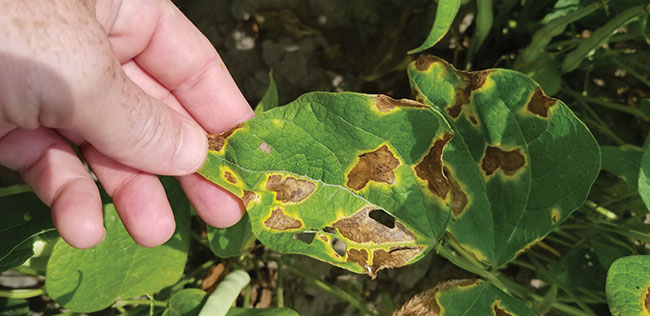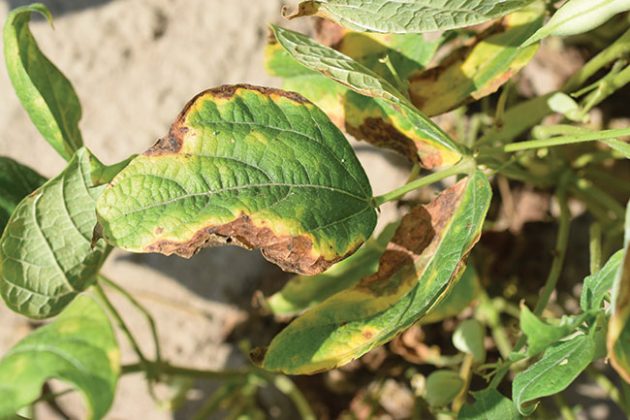
Features
Diseases
Pulses
Spotlight on bacterial brown spot
Towards better control of this emerging threat and other bacterial diseases in dry bean.
November 20, 2020 By Carolyn King
 Bacterial brown spot is emerging as the most important bacterial disease in Ontario dry beans. Photo COURTESY OF Owen Wally.
Bacterial brown spot is emerging as the most important bacterial disease in Ontario dry beans. Photo COURTESY OF Owen Wally. Bacterial blights – such as common bacterial blight, halo blight and bacterial brown spot – can cause serious problems in dry beans. Until recently, common bacterial blight was thought to be the most important of these blights in Ontario. But new research is showing that the biggest concern is now bacterial brown spot (BBS), for which there are no really effective control measures.
“We are finding that bacterial brown spot is often misdiagnosed as common bacterial blight, leading to underestimates of bacterial brown spot,” says Owen Wally, pulse pathologist with Agriculture and Agri-Food Canada (AAFC) in Harrow, Ont., who is leading this research. “I think bacterial brown spot is probably number two on the list of the most damaging diseases in Ontario dry beans currently, right after white mould.”
In a five-year study (2018 to 2023), Wally and his research group aim to get a better handle on the occurrence and yield impacts of BBS and other bacterial diseases in Ontario dry bean crops, and are working on new ways to control these diseases.
Bacterial brown spot 101
Bacterial brown spot is caused by Pseudomonas syringae pathovar syringae (“pathovar,” or “pv.,” refers to a type of bacterial strain). “This pathogen can affect the foliage, pods and seeds of dry bean plants. The symptoms start as small, brown, water-soaked lesions. Under the right conditions, these can spread fairly rapidly on both the pods and the leaves,” Wally explains.
“On the leaves, those little lesions will start to coalesce and form larger lesions and become completely necrotic. Although it varies, the lesions will often develop a pale-yellow ring around the outside of the necrotic areas as the disease progresses. As the disease progresses further, it can cause a lot of defoliation. When bacterial brown spot affects the pods, it can lead to seed abortion, so the seeds just sit there and don’t mature.”
Like common bacterial blight (CBB) and halo blight (HB), BBS requires high humidity. However, BBS tends to favour temperatures from 12 to 20 C, more moderate than CBB prefers. Wally notes, “These humid and somewhat cooler conditions are common in the evenings and early mornings in a lot of the Ontario bean-growing regions. For instance, a heavy dew or fog in the morning provides optimal conditions for bacterial brown spot.”
Although BBS can be seed-borne, Wally doesn’t think the disease is coming from the seed. “Almost all of the dry bean production in Ontario uses certified, disease-free seed. That seed usually comes from Idaho, which is very dry [so these bacterial diseases are not a concern].”
He adds, “Even when Ontario-grown seed is not showing any symptoms, there is always going to be a minor amount of [bacterial disease on the seed] because of the humid conditions in Ontario. If you plant that seed again, the disease problem will get much, much worse. So, Ontario growers have to pay quite a premium to get seeds from Idaho.”
Wally thinks BBS is coming from crop residues and alternative hosts in and around bean fields. “Bacterial brown spot has a very broad host range. The pathogen infects many other species, such as corn, [some other legume crops, wheat, barley] and some perennial and annual weed species. For example, the pathogen causes a minor disease on corn called Holcus spot, which is not treated because it doesn’t attack corn yields. But growers often have beans in rotation with corn, so we think this is probably where most of the inoculum is coming from.”
Given its wide host range, Wally suspects that the BBS pathogen is probably present in much of Ontario and just needs the right conditions to make the disease flare up in dry bean crops.
“If the pathogen is on the bean seed to begin with, then it is already within the plant cells and the disease will progress quite rapidly. If the pathogen is coming from crop residues, then the bean plant would need to have some sort of wounding event so that the bacteria can enter; bacteria cannot directly invade plant cells,” he explains.
“Wounding events could be high winds and especially hail. We also think insects play a role. They may not directly vector the pathogen, but they may be moving it around and causing damage to the leaves and pods where the bacteria can enter the plant.”
For Ontario bean growers, BBS stepped into the spotlight in 2014 when the disease caused serious problems in adzuki bean crops. Wally says, “Adzuki beans are extremely susceptible to bacterial brown spot, but the disease affects pretty much all the market classes of dry beans grown in Ontario.”
He notes, “We don’t really know the impact of bacterial brown spot on yield, but it has been estimated to be as high as 40 per cent in some severe cases. We think it is somewhere between five and 10 per cent under normal conditions without the disease really having been noticed. So, the average field might see that type of yield loss.”
Control challenges
“Currently, there are not really any effective options for controlling bacterial brown spot,” Wally says. Longer crop rotations don’t help to control BBS because of the pathogen’s many other hosts.
No Ontario dry bean varieties are known to have BBS resistance. In contrast, breeders have developed many CBB-resistant varieties for Ontario, such as Rexeter, Mist, Lighthouse, Apex and AAC Argosy.
Copper-based products are available for in-crop spraying to help slow the growth and spread of BBS, HB and CBB. However, these products often have limited effectiveness, depending on factors like weather, disease pressure and the particular bacterial pathogen.
“Streptomycin used to be the main seed treatment for controlling bacterial diseases in bean crops, but it is no longer registered,” Wally notes.
Using certified seed is important to help prevent the disease situation from worsening.
Another challenge is figuring out whether BBS or some other bacterial pathogen is causing the symptoms. “The symptoms of bacterial brown spot, halo blight and common bacterial blight can fool most people, including myself sometimes, because they look very, very similar. Bacterial brown spot and common bacterial blight look almost identical,” Wally says.
“The lesions [in all three diseases] have brown, necrotic centres, but the ring of the chlorosis [yellowing] is typically smaller with bacterial brown spot as compared to halo blight and common bacterial blight. On the pods, bacterial brown spot lesions are slightly smaller than common bacterial blight lesions.” With BBS, the leaves tend to look more tattered.
Genetic sequencing is the most reliable way to tell the diseases apart. HB is caused by Pseudomonas syringae pv. phaseolicola. CBB is caused by Xanthomonas axonopodis pv. phaseoli and Xanthomonas fuscans subspecies fuscans.

Common bacterial blight symptoms (shown here) look very similar to bacterial brown spot symptoms. Photo courtesy of Owen Wally.
BBS predominates in surveys
Wally’s bacterial blight research is targeting BBS, CBB, and HB, as well as bacterial wilt. Bacterial wilt in dry bean is caused by Curtobacterium flaccumfaciens pv. flaccumfaciens; some reports indicate bacterial wilt may be resurging in North America.
Part of Wally’s research is focused on improving our understanding of the Ontario situation for these four diseases. “We want to determine the impact that these bacterial diseases are having on bean production in Ontario – how much are they impacting yields and under what conditions do these yield impacts happen? We also want to find out how widespread they are in Ontario,” he explains.
“In addition, we want to determine the genetic diversity of these different bacterial
populations, if there are different races or if they differ in virulence within these different growing regions.”
So, Wally and his research group, along with collaborators throughout Ontario’s bean-growing regions, are collecting samples of symptomatic plant tissues. In 2018 and 2019, they collected about 30 samples.
In the lab, they isolate any bacteria present in these samples. Next, they do genetic analysis, including DNA sequencing, to confirm the species. And then they do virulence testing to make sure the isolates cause disease in bean plants.
“Close to 90 per cent of the isolates so far have turned out to be bacterial brown spot,” Wally notes. “These samples came from people who thought the symptoms were common bacterial blight.”
Developing BBS-resistant varieties
Another component of this research involves screening dry bean lines for resistance to bacterial diseases. In this work, Wally is collaborating very closely with Jamie Larsen, who leads AAFC’s dry bean breeding program at Harrow.
As part of this component, they set up a new BBS disease nursery at AAFC’s London research centre in 2019, and they are also doing indoor BBS screening.
The BBS nursery joins AAFC’s CBB nursery in Harrow and HB nursery in London. These three field nurseries are used to screen dry bean varieties in the Ontario registration trials, as well as some advanced lines from Larsen’s program and the University of Guelph’s breeding program. The nurseries are irrigated and inoculated with the appropriate pathogen to increase the probability of disease development.
“From the variety screening, we are finding definite varietal differences in the response to bacterial brown spot. So, there could be some genetic resistance already within some bean lines. So far, it seems that the large-seeded bean market classes are a little more tolerant to brown spot than the small-seeded market classes,” Wally says.
He adds, “Once we start publishing the varietal differences, growers will be able to select cultivars that have more tolerance to bacterial brown spot.”
Wally is excited about the potential to develop BBS-resistant varieties for Ontario. “This would provide growers with an effective way to manage one of the major disease problems in Ontario dry bean crops.”
The longer-term goal is to develop bean varieties with resistance to multiple diseases, particularly CBB, BBS and anthracnose. “Further down the road, if we get enough resistance packages together, growers might be able to use Ontario-grown seed for regrowing in Ontario instead of having to pay a premium for Idaho-grown seed.”
Testing new seed treatments
Wally is also involved in a cross-Canada study to evaluate novel seed treatments for managing bacterial diseases in beans. “We’re trying to find some alternatives to streptomycin. If we can find suitable seed treatments, they could be easily added to the existing treatment packages for dry beans.”
In Harrow, Wally’s group is assessing the effectiveness of about eight different seed treatment products in controlling BBS, CBB, HB and bacterial wilt. They are testing the products on both Ontario-grown seeds and on Idaho-grown certified seeds.
He notes, “There is some evidence that [the efficacy of] some of these seed treatments can last a fairly long time within the plant, almost to maturity, because they are not working directly on the pathogen but they are influencing the plant to produce different responses.”
Wally’s bacterial disease research will help provide much-needed information and tools for Ontario dry bean growers to manage BBS and other bacterial diseases.
This research is funded through the Canadian Agricultural Partnership’s Pulse Cluster: a partnership between AAFC and the Ontario Bean Growers and other pulse agencies across Canada.